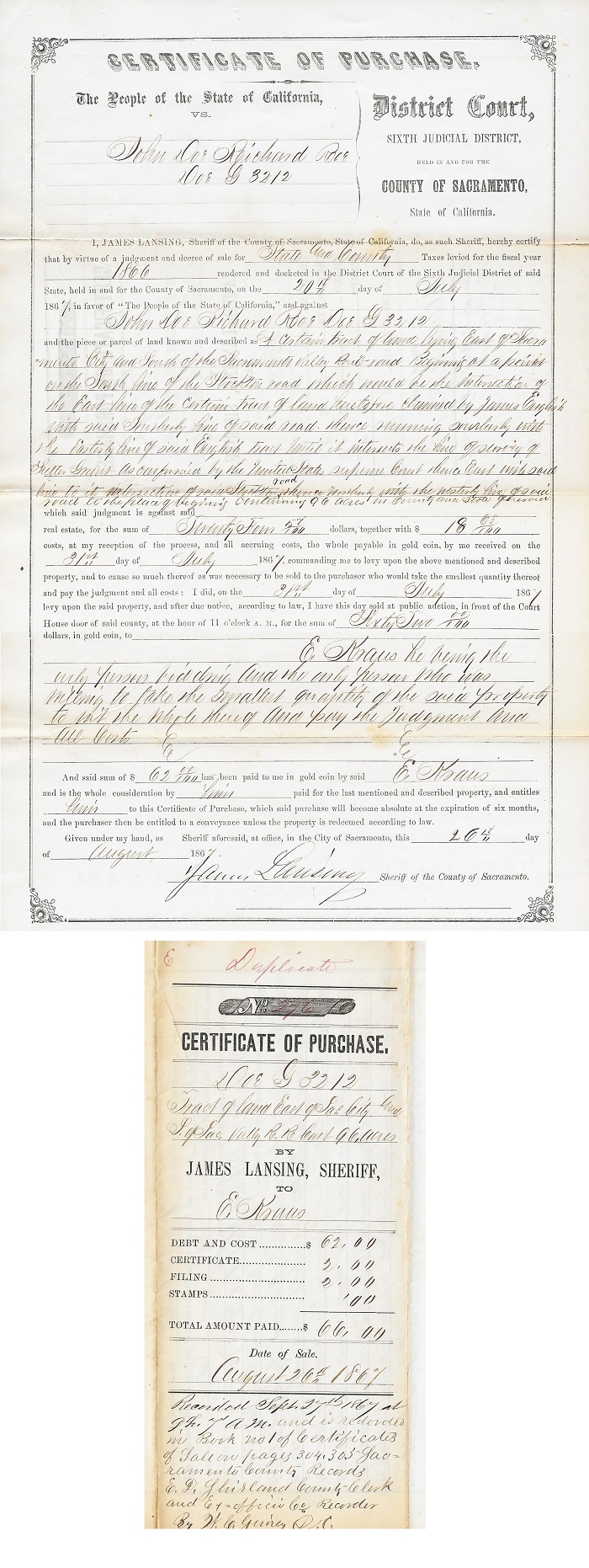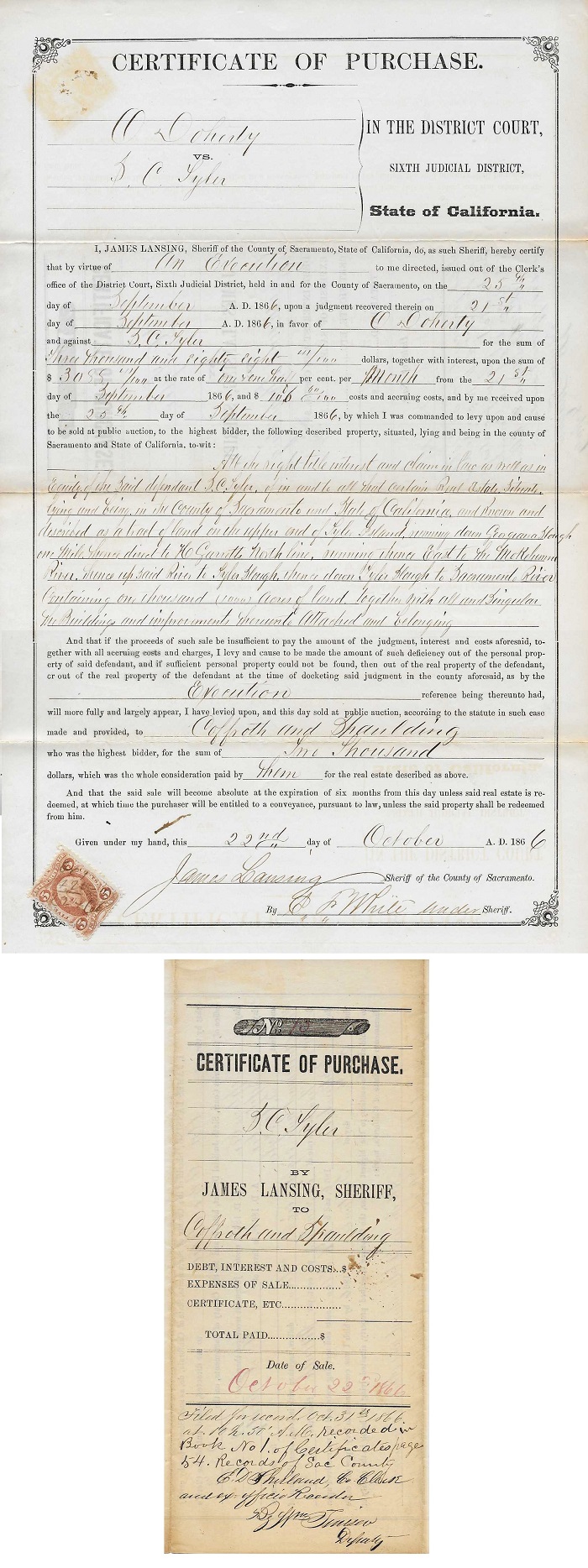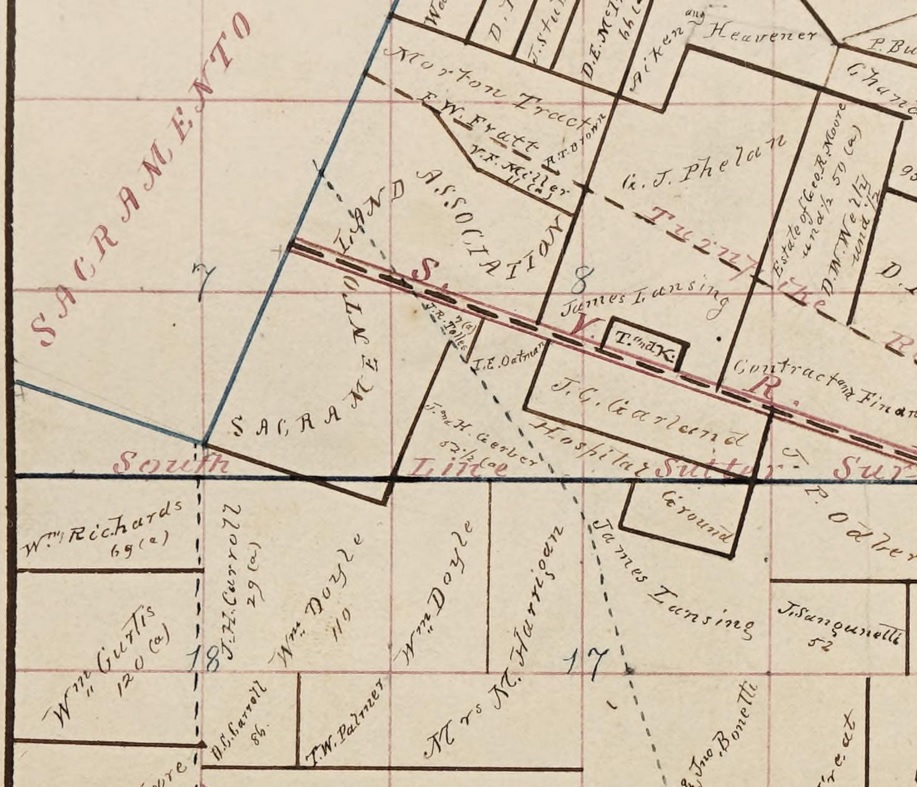
James Lansing was a California Pioneer who was elected as Sacramento County’s Sheriff in 1865 and served through 1867. In 1861 he was hired as a Deputy Sheriff by Sheriff Benjamin Norton Bugbey. Bugbey would go on to vote for Lansing as Sheriff at a political cost to himself. Lansing was a Democrat and Bugbey was a member of the Union Party in 1865. Some people viewed Bugbey’s vote for Lansing as support for a Confederate sympathizer.
Regardless of the politics of the 1860s, Lansing was generally viewed favorably in Sacramento County. In addition to being s Sheriff’s Deputy, he would also serve as a Sacramento City Marshall and also as Sacramento County Assessor for four years.
Sacramento Sheriff James Lansing
Lansing was born Lansingburgh, New York, in 1826. He came to California in 1849 in search of gold. He was active in numerous organizations including the Settler’s Committee, Sacramento Society of California Pioneers, Order of Odd Fellows, Exempt Fireman’s Association, Order of Chosen Friends, and the Knights of Pythias. He died from a random shooting behind the hotel he and his wife had recently opened on K Street in Sacramento in 1882 at Third and K Streets.
His death bed statement of events was recorded and witnessed by his friend B. N. Bugbey.
My name is James Lansing. I am 56 years of age. I know l am going to die, and make this statement under the impending crisis of the immediate presence of my demise. I do not know the man who shot me. I may have seen him, but if I did, I do not know it. I had no difficulty with him. I was out in the back yard of my hotel helping fix up a car load of coal about 4 p. m. I saw a man running down the alley and heard people halloo after him. I then started in pursuit. I followed about 100 feet. I did not run fast, neither did the man. I only wanted to see what the matter was. He turned on me, and I saw he had a pistol in his hand, and I attempted to turn, but before I could turn, he fired, when about fifteen feet from me. I knew that I was hit, but did not feel at first any sensation. I then ran all the way back, and just as I arrived at the hotel, I began to feel the effects, and came into room 9, where I now am, and I now feel that I must die and make this statement with that feeling. (Signed), James Lansing
Sacramento Daily Union, Volume 15, Number 42, 11 April 1882
One of the duties of the sheriff was to sell property either decreed in a court judgement or for delinquent taxes. I was able to purchase 3 such documents signed by Sheriff James Lansing. There is nothing particularly special about any of the sales from 1866 through 1868. They are almost routine records, similar to the many other sales, that all sheriffs at the time conducted.
If nothing else, these original documents, when Sacramento was not yet 20 years old, gives a brief glimpse into the government business of the young city. They also provide a few clues to the people mentioned in the documents, either from their precarious financial situation or the speculative nature of the purchase.
Sale to Edward O. Kraus
In 1867, the Sixth Judicial Court in Sacramento County, order 96 acres east of the city of Sacramento sold for unpaid taxes. On July 31st, Sheriff Lansing auctioned off the property and the high bidder was Edward Kraus, a local Sacramento resident. The final bid price was $62.00.
Property Description
A certain tract of land lying east of Sacramento City and south of the Sacramento Valley Railroad and beginning at a point on the south line of the Stockton road which would be the intersection of the east line of the certain tract of land theretofore claimed by James English with said southerly line of said road, thence running southerly with the easterly line of said English tract until it intersects the line of (easterly) of the Sutter Grant as confirmed by the United States supreme Court thence east mile said line to it intersecting of said Stockton road and northerly with the westerly line of said road to the place of beginning, containing 96 acres in county and state of aforesaid.
E. Kraus he being the only person bidding and the only person who was willing to take the smallest quantity of the said property to wit the whole there and pay the judgement and all costs.
Debt and costs of $62.00
Certificate $ 2.00
Filing $ 2.00
Total amount $66.00
Recorded September 27, 1867 at gh. 7am and is recorded in Book no 1 of Certificates of Sale on pages 304, 303, Sacramento County, Records. E. D. Shirland County Clerk and Ex-officio County recorder by W. C. Guirey D. C.

The 1870 Sacramento County Assessors map does not show any property in that vicinity being owned by Kraus. There is a land deed recording of a transfer of property between Kraus and the gentleman mentioned in the property description of James English. As was sometimes the case, a friend or relative would bid on the property at auction and then deed it back the original owner who was in default of their property taxes.
While the property ownership does not show on the 1870 assessor map, several parcels belonging to James Lansing are noted.
Edward Kraus was born in Germany and became a naturalized citizen in 1855. He would go on to sponsor several men for citizenship in Sacramento. His primary occupation was as a hotel keeper in Sacramento. In 1865 he advertised for information on the whereabouts of Nicolaus Weier with the cryptic message.

Kraus helped found the Sacramento Hussars that emulated the Hungarian light horsemen cavalry regiment. He was also involved with the German community in Sacramento, along with Augustus Heilbron. One of the German communities’ goals in 1869 was to get the Sacramento public school system to teach the German language.
Kraus died in March 1890. His funeral announcement noted the Exempt Fireman’s Association and the Sacramento Hussar Band was in attendance. The Sacramento Daily Union reported it was one of the largest funerals that had taken place in the city in sometime.
Sale of Cornelius Bagnall Property To John Stott
Lansing also presided over the sale of several Sacramento city lots for delinquent taxes from the 1866 – 1867 period. The lots were owned by Cornelius Bagnall and the high bidder was John Stott.
Property Description
Judgement December 31, 1867 against C. & J. Bagnall
John Doe Richard Roe and the piece or parcel of land known and described as lots No. one (1), three (3), four (4), five (5) and seven (7) in the block between M and N and Twenty-fifth (25th) and Twenty-sixth (26th) streets and the improvements on lot number two (2) of said blocks in the city and County of Sacramento and State of California for the of Four 60/100 dollars for City taxes levied for the year 1866 – 7 and $8 05/100 costs.
Commanded on the 21st January 1868 to sell real estate. Sold February 17, 1868 to John Stott for Sixteen 65/100. Witness James Lansing Ex-Sheriff, August 19, 1868. Recorded August 22, 1868, Book no. 42 of tax deeds on pages 370 and 371.
Bagnall, who was from England, was listed as one of the owners of the lots. Bagnall listed his occupation as dairyman in 1867. He died in 1877 at the age of 73.
John Stott was also from England. In 1866 Stott listed his occupation as plasterer and lived on 6th Street between G and H. By 1872 Stott was listing his occupation as proprietor of the Free and Easy Saloon at 2nd and K Streets, which was also listed as his residence. At the time of the purchase of the lots from Lansing, Stott was only 37 years old. Stott died in 1887 at the age of 57. The cause of death was listed as Bright’s Disease. Today, Bright’s disease is known as acute or chronic nephritis. A kidney disease characterized by swollen kidneys, albumin in the urine, accompanied with high blood pressure.
There is a deed recording of property from Stott to Bagnall. It’s possible, Stott bought the property and then deeded it back to Bagnall.
1,000 Acres on Tyler Island Sold to Coffroth and Spaulding
On September 21, 1866, the Sixth Judicial District Court in Sacramento ruled in favor of O. Doherty against S. C. Tyler for the sum of $3,088.41. I could not find any mention over what the dispute was regarding. Both Doherty and Tyler were property owners in Sacramento-San Joaquin Delta region, better known in the day as Swamp and Overflow Lands.
To settle the judgement, Sheriff Lansing auctioned off 1,000 of delta land owned by S. C. Tyler. The property description being:
All the right title interest and claim in law as well as in Equity of the said defendant S. C. Tyler, of in and to all that certain Real Estate situated, lying and being in the County of Sacramento and State of California, and known and described as a tract of land on the upper end of Tyler Island, running down Georgiana Slough one mile. Thence direct to H. Garretts north line, running thence east to the Mokelumne River, thence up said river to Tyler Slough, thence down Tyler Slough to Sacramento River. Containing one thousand (1,000) acres of land, together with all and singular the buildings and improvements thereunto attached and belonging.

The high bidder was the law firm of Coffroth and Spaulding for $2,000 on October 22, 1866.
James Coffroth was active in local Sacramento politics and at one point on the state central committee for the Democratic party in 1866. As a local attorney, Coffroth represented many different people from criminal offences to civil litigation. Coffroth and Spaulding were also property owners and purchased distressed properties. They owned bridge on Cosumnes River, damaged by floods in 1866.
Higher resolution images of the document can be found in the IMK File Explorer 1866 Sheriff Lansing Sacramento
1866 Sheriff Lansing Sacramento
In can be difficult to trace the ultimate disposition of properties from the Sheriff Sales. However, on the Sacramento County online deed search, Coffroth and Spaulding did sell land to Louis Winter, who was already a property owner on Tyler Island. This may be the land they purchased at auction.
Sources of the information for this post are Ancestry.com, California Digital Newspaper Collection, Sacramento County Vital Records.





